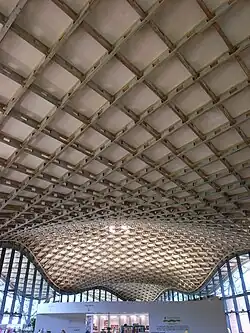Chris J. K. Williams | |
|---|---|
| Born | Christopher J. K. Williams |
| Nationality | British |
| Known for | shell structures, gridshells, optimisation, geometry |
| Academic work | |
| Discipline | Engineer |
| Institutions | University of Bath, Chalmers University of Technology |
| Notable works | Queen Elizabeth II Great Court, Savill Building, Multihalle Mannheim, Netherlands Maritime Museum, Gardens by the Bay |
Christopher John Kenneth Williams is a British structural engineer and researcher who has specialised in the relationship between geometry and structural action. He works on a range of building types including thin-shell structures, gridshells and tension structures, as well as bridges and towers.
Williams worked for Ove Arup in the 1970s.[1] While at Arup, he was involved with the Mannheim Multihalle (de), a pioneering timber gridshell designed by Frei Otto (1975).[1][2] He has since devoted most of his career to academia, conducting research and teaching at the University of Bath (from 1976)[2] and at Chalmers University of Technology in Gothenburg, Sweden (since 2016). While at Bath, in collaboration with Deborah Greaves, he researched the effect of wind on fabric,[2] and he continues to work on the effect of wind on flexible structures.[3]

Some of Williams' most notable subsequent contributions include:
- the geometrical form finding and structural analysis for the glass roof covering the Queen Elizabeth II Great Court at the British Museum (2000)[4]
- form finding for the cardboard gridshell of the Japan Pavilion, Hanover Expo 2000, Germany (2000)[1][2]
- form finding for the Weald and Downland Gridshell (2001)[1][2]
- the gridshell of Savill Building (2006)[2][5]
- Gardens by the Bay glasshouses, Singapore (2010)[2]
- the glass roof of the Netherlands Maritime Museum (2011)[2]
- the glass roof of the Chadstone Shopping Centre (2016)[6]
He has collaborated with architects and engineers including Foster + Partners, Rogers Stirk Harbour + Partners, Branson Coates Architecture, Shigeru Ban Architects, Wilkinson Eyre Architects, Edward Cullinan Architects, Arup, Atelier One and Buro Happold.[7]
Bibliography
- S. Adriaenssens, P. Block, D. Veenendaal, and C. Williams, Eds., Shell Structures for Architecture: Form Finding and Optimization. London: Taylor & Francis - Routledge, 2014. ISBN 978-0-415-84060-6
- N. Leach, D. Turnbull, C. J. K. Williams, Eds., Digital Tectonics. Chichester, UK: Wiley, 2004. ISBN 978-0-470-85729-8
References
- 1 2 3 4 Chilton & Tang, pp. 52–53, 66
- 1 2 3 4 5 6 7 8 "Clever Roofs: Innovative Methods to Cover Large Open Spaces". Research Excellence Framework. 2014. Retrieved 1 April 2018.
- ↑ "Christopher John Kenneth Williams". Chalmers University of Technology. Retrieved 1 April 2018.
- ↑ Williams, Chris J. K. (2001). Burry, Mark; Datta, S.; Dawson, A.; Rollo, A.J. (eds.). "The analytic and numerical definition of the geometry of the British Museum Great Court Roof". The Proceedings of Mathematics and Design 2001. Deakin University, Geelong, Victoria 3217, Australia: 334–440.
{{cite journal}}: CS1 maint: location (link) - ↑ Chilton & Tang
- ↑ "Projects". atelier one. Retrieved 3 April 2018.
- ↑ "Dr Chris Williams". University of Bath. Retrieved 31 March 2018.
Sources
- Chilton, John; Tang, Gabriel (2017). Timber Gridshells: Architecture, Structure and Craft. Routledge. ISBN 9781138775305.